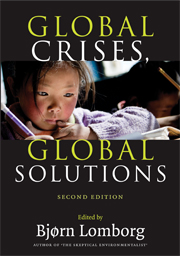Book contents
- Frontmatter
- Contents
- List of figures
- List of tables
- List of contributors
- Acknowledgements
- List of abbreviations and acronyms
- Introduction
- PART I THE CHALLENGES
- 1 Air pollution
- 2 The security challenge in conflict-prone countries
- 3 Disease control
- 4 The benefits and costs of alternative strategies to improve educational outcomes
- 5 Climate change
- 6 Hunger and malnutrition
- 7 Water and sanitation
- 8 The challenge of reducing international trade and migration barriers
- 9 Transnational terrorism
- 10 Women and development
- PART II RANKING THE OPPORTUNITIES
- Conclusion
10 - Women and development
Published online by Cambridge University Press: 05 June 2012
- Frontmatter
- Contents
- List of figures
- List of tables
- List of contributors
- Acknowledgements
- List of abbreviations and acronyms
- Introduction
- PART I THE CHALLENGES
- 1 Air pollution
- 2 The security challenge in conflict-prone countries
- 3 Disease control
- 4 The benefits and costs of alternative strategies to improve educational outcomes
- 5 Climate change
- 6 Hunger and malnutrition
- 7 Water and sanitation
- 8 The challenge of reducing international trade and migration barriers
- 9 Transnational terrorism
- 10 Women and development
- PART II RANKING THE OPPORTUNITIES
- Conclusion
Summary
Introduction
Gender shapes one's role at home, in society, and in the economy. All cultures interpret and translate men's and women's biological differences into expectations about what behaviors and activities are appropriate for them and what rights, resources, and power they possess. Over the past three decades, these gender differences have increasingly gained prominence in the development agenda. More attention is being given to the plight of poor and disadvantaged women in developing countries, as well as to the unfinished gender agenda in more developed countries. Recognizing the importance of ensuring equal opportunities for females and males on grounds of both fairness and efficiency and as an instrument for achieving poverty reduction and economic growth, the international development community has included gender equality among the Millennium Development Goals (MDGs).
MDG3 reflects the strong belief by the development community that starkly unequal access to assets and opportunities between men and women produce further inequalities, harming not only women but also their families, and their communities. For example, disparities in education, employment, and wages hurt the women affected and also reduce the overall efficiency of the economy. Gender disparities that begin at a young age have significant long-term effects and are more costly to overcome later. Restricting the pool of educated people to boys reduces the overall talent pool.
- Type
- Chapter
- Information
- Global Crises, Global SolutionsCosts and Benefits, pp. 585 - 654Publisher: Cambridge University PressPrint publication year: 2009
- 7
- Cited by



